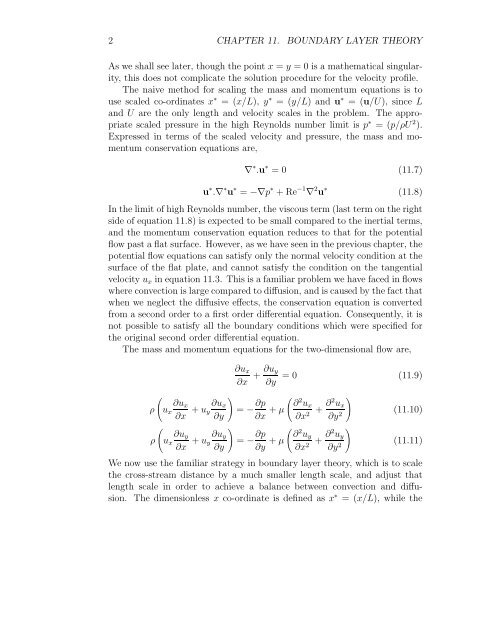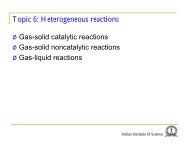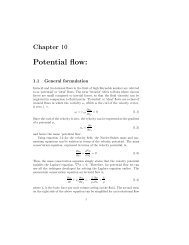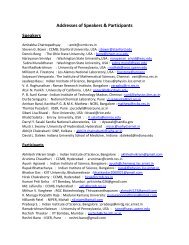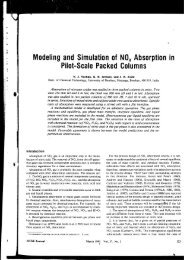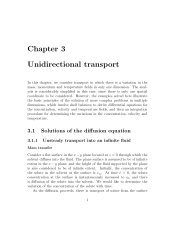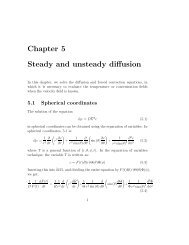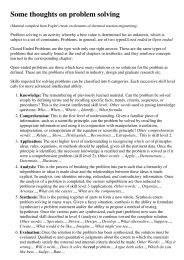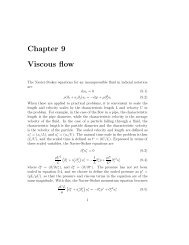Chapter 11 Boundary layer theory
Chapter 11 Boundary layer theory
Chapter 11 Boundary layer theory
Create successful ePaper yourself
Turn your PDF publications into a flip-book with our unique Google optimized e-Paper software.
2 CHAPTER <strong>11</strong>. BOUNDARY LAYER THEORY<br />
As we shall see later, though the point x = y = 0 is a mathematical singularity,<br />
this does not complicate the solution procedure for the velocity profile.<br />
The naive method for scaling the mass and momentum equations is to<br />
use scaled co-ordinates x ∗ = (x/L), y ∗ = (y/L) and u ∗ = (u/U), since L<br />
and U are the only length and velocity scales in the problem. The appropriate<br />
scaled pressure in the high Reynolds number limit is p ∗ = (p/ρU 2 ).<br />
Expressed in terms of the scaled velocity and pressure, the mass and momentum<br />
conservation equations are,<br />
∇ ∗ .u ∗ = 0 (<strong>11</strong>.7)<br />
u ∗ .∇ ∗ u ∗ = −∇p ∗ + Re −1 ∇ 2 u ∗ (<strong>11</strong>.8)<br />
In the limit of high Reynolds number, the viscous term (last term on the right<br />
side of equation <strong>11</strong>.8) is expected to be small compared to the inertial terms,<br />
and the momentum conservation equation reduces to that for the potential<br />
flow past a flat surface. However, as we have seen in the previous chapter, the<br />
potential flow equations can satisfy only the normal velocity condition at the<br />
surface of the flat plate, and cannot satisfy the condition on the tangential<br />
velocity u x in equation <strong>11</strong>.3. This is a familiar problem we have faced in flows<br />
where convection is large compared to diffusion, and is caused by the fact that<br />
when we neglect the diffusive effects, the conservation equation is converted<br />
from a second order to a first order differential equation. Consequently, it is<br />
not possible to satisfy all the boundary conditions which were specified for<br />
the original second order differential equation.<br />
The mass and momentum equations for the two-dimensional flow are,<br />
(<br />
∂u x<br />
ρ u x<br />
∂x + u y<br />
(<br />
∂u y<br />
ρ u x<br />
∂x + u y<br />
∂u x<br />
∂x + ∂u y<br />
∂y = 0 (<strong>11</strong>.9)<br />
)<br />
∂u x<br />
= − ∂p<br />
∂y<br />
)<br />
∂u y<br />
∂y<br />
( ∂ 2 )<br />
∂x + µ u x<br />
∂x + ∂2 u x<br />
2 ∂y 2<br />
= − ∂p ( ∂ 2 )<br />
∂y + µ u y<br />
∂x + ∂2 u y<br />
2 ∂y 2<br />
(<strong>11</strong>.10)<br />
(<strong>11</strong>.<strong>11</strong>)<br />
We now use the familiar strategy in boundary <strong>layer</strong> <strong>theory</strong>, which is to scale<br />
the cross-stream distance by a much smaller length scale, and adjust that<br />
length scale in order to achieve a balance between convection and diffusion.<br />
The dimensionless x co-ordinate is defined as x ∗ = (x/L), while the


